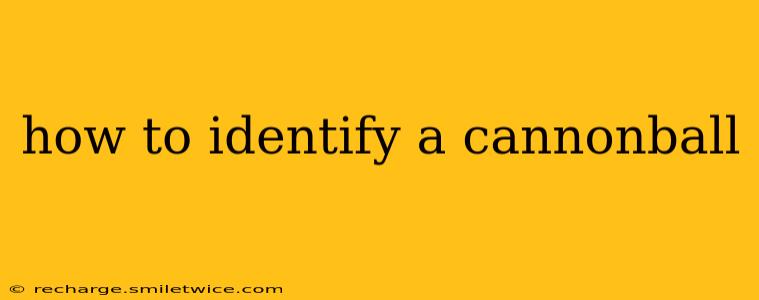Cannonballs, remnants of a bygone era of naval warfare and land battles, hold a fascinating allure for history buffs, metal detector enthusiasts, and curious collectors alike. Identifying a genuine cannonball, however, requires a keen eye and understanding of their characteristics. This guide will provide you with the knowledge to distinguish a true cannonball from look-alikes.
What are the Key Characteristics of a Cannonball?
Authentic cannonballs possess several key features that set them apart from other similar-looking objects. Understanding these characteristics is crucial for accurate identification.
- Material: Historically, cannonballs were primarily made of cast iron. While other materials like stone were used in earlier periods, iron is the most common material found today. This means the object should have the weight and feel of cast iron.
- Shape: Genuine cannonballs are typically spherical, though slight imperfections are common due to the casting process. Significant deviations from a perfect sphere might suggest a different origin.
- Surface Texture: The surface of a cannonball often exhibits a rough texture, due to the casting process and potential weathering over time. You might find pitting, imperfections, or even remnants of original surface treatments.
- Size and Weight: Cannonballs varied greatly in size depending on the cannon they were fired from. Sizes ranged from small, hand-held projectiles to much larger ones requiring significant effort to move. Their weight is a significant indicator – a deceptively light object claiming to be a cannonball is likely a fake.
- Presence of a Fuse Hole (Rare): Some cannonballs, particularly those intended for explosive purposes, possessed a small hole (fuse hole) to accommodate a fuse or other incendiary device. The presence of such a hole is a strong indicator of authenticity but is not always present.
How Can I Tell if It's Just a Very Round Rock?
This is a common question. Differentiating between a cannonball and a very round rock relies on a combination of factors:
- Weight: A rock of comparable size will generally be significantly lighter than an iron cannonball.
- Material Composition: A simple scratch test, if permissible on the object, might reveal the underlying material. Iron will have a metallic sheen and feel quite different to the texture of a stone. A magnet can also be helpful; iron will strongly attract a magnet.
- Surface Texture: While rocks can be smooth or rough, the texture of a cannonball often exhibits a more consistent, less naturally occurring texture.
What About Other Potential Look-alikes?
Besides rocks, other objects might resemble cannonballs:
- Industrial Spheres: Modern industrial processes create many spherical objects. However, these often have a smoother, more uniform surface than antique cannonballs.
- Decorative Spheres: Ornamental balls made from various materials can easily be mistaken for cannonballs. Examining the material and the overall finish will help distinguish them.
How Can I Determine the Age and Origin of a Cannonball?
Determining the precise age and origin requires expertise and potentially professional analysis. Factors to consider include:
- Surface Condition: The level of corrosion, pitting, and weathering can provide clues to its age and exposure to the elements.
- Material Analysis: Advanced techniques, such as metallurgical analysis, can determine the exact composition of the metal, potentially providing information about its origin and manufacturing process.
- Historical Context: The location where the cannonball was found might offer significant context, indicating potential battles or historical events.
Is it Worth Anything?
The value of a cannonball varies greatly depending on its condition, size, historical significance, and provenance. Well-preserved, historically significant cannonballs can be quite valuable to collectors and museums. However, many common cannonballs hold more historical interest than monetary worth. Getting an appraisal from a reputable antique dealer or appraiser is recommended if you suspect you have a valuable find.
This guide offers a comprehensive approach to cannonball identification. Remember, if you are unsure about an object's authenticity, consulting with a historian or expert in antique weaponry is always recommended. Handle all potentially historical artifacts with care to preserve their integrity.
